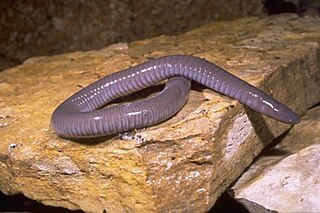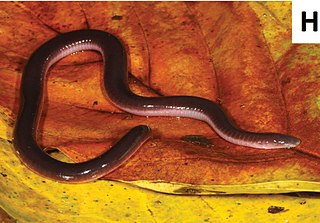
Caecilians are a group of limbless, vermiform (worm-shaped) or serpentine (snake-shaped) amphibians with small or sometimes nonexistent eyes. They mostly live hidden in soil or in streambeds, and this cryptic lifestyle renders caecilians among the least familiar amphibians. Modern caecilians live in the tropics of South and Central America, Africa, and southern Asia. Caecilians feed on small subterranean creatures such as earthworms. The body is cylindrical and often darkly coloured, and the skull is bullet-shaped and strongly built. Caecilian heads have several unique adaptations, including fused cranial and jaw bones, a two-part system of jaw muscles, and a chemosensory tentacle in front of the eye. The skin is slimy and bears ringlike markings or grooves and may contain scales.

Ichthyophis garoensis, the Garo Hills caecilian, is a species of caecilian found in Assam and Meghalaya in north-eastern India. The Husain's caecilian Ichthyophis husaini was until 2016 considered a separate species. It is a subterranean caecilian that lives in the moist leaf-litter of tropical forests. It is typically found close to streams and other waterbodies.
Gegeneophis carnosus is a species of caecilian found in Karnataka and Kerala states, India. Its common name Periah Peak caecilian refers to its type locality, though it is also known under names blind caecilian and pink blind caecilian.
Gegeneophis ramaswamii, common names Tenmalai caecilian, Tenmalai blind caecilian, Ramaswami's caecilian, and forest caecilian is a species of caecilian. It is endemic to the southern portion of the Western Ghats, India, and is recorded from Kerala and Tamil Nadu. The specific name ramaswamii honours L. S. Ramaswami, an Indian herpetologist.

Caecilia tentaculata is a species of caecilian in the family Caeciliidae. It is found in Brazil, Colombia, Ecuador, French Guiana, Peru, Suriname, Venezuela, possibly Bolivia, and possibly Guyana. Its natural habitats are subtropical or tropical moist lowland forests, plantations, rural gardens, and heavily degraded former forest.

Chthonerpeton indistinctum is a species of caecilian in the family Typhlonectidae. It is found in northeastern Argentina, Paraguay, Uruguay, and southeastern Brazil. The common name Argentine caecilian has been coined for it.

Dermophis mexicanus, also known commonly as the Mexican burrowing caecilian or the Mexican caecilian, and locally as the tapalcua or tepelcua, is a species of limbless amphibian in the family Dermophiidae. The species is native to Mexico and Central America, where it burrows under leaf litter and plant debris.

Schistometopum thomense is a species of amphibian in the family Dermophiidae, endemic to São Tomé and Ilhéu das Rolas. It is found in most soils on São Tomé, from tropical moist lowland forests to coastal coconut plantations. It is absent only from the driest northern areas of the island. It is typically around 30 cm (12 in) in length, and is often bright yellow. The size of S. thomense can vary throughout São Tomé, however, and it is the only known caecilian to follow Bergmann's rule, which states that a decreasing temperature due to factors such as increasing altitude will cause an increase in the body size of endothermic vertebrate species. The island of São Tomé is a massive shield volcano, and it therefore has differing altitudes throughout the island, potentially resulting in the size diversity of S. thomense. This species may be referred to as the São Tomé caecilian, as the Agua Ize caecilian, or as the island caecilian, or by the local name of cobra bobo.

Siphonops annulatus, the ringed caecilian, is a species of caecilian in the family Siphonopidae from South America. It might have the broadest known distribution among terrestrial caecilian species.

Siphonops is a genus of caecilians in the family Siphonopidae, found in South America. All species are known to occur within Brazil, however, only S. hardyi and S. leucoderus are endemic to it. The native ranges of the other two known species, S. annulatus and S. paulensis, extend outwards into the surrounding countries of Argentina, Bolivia, and Paraguay. S. annulatus's range extends even further, stretching into Colombia, Ecuador, French Guiana, Guyana, Peru, Suriname, and Venezuela, and giving it perhaps the most widespread distribution of any single caecilian species.
Siphonops hardyi, or Hardy's caecilian, is a species of caecilian in the family Siphonopidae. It is endemic to southeastern Brazil where it occurs in the states of São Paulo, Rio de Janeiro, Espírito Santo, and Minas Gerais, possibly wider. This species lives in soil and under leaf litter or stones in primary forest, plantations, and rural gardens. It is a common species; it can locally suffer from infrastructure development but is not generally threatened.
Siphonops leucoderus, the Salvador caecilian, is a species of caecilian in the family Siphonopidae. It is endemic to eastern Brazil and only known from its type locality, the Bahia state. It is assumed to be a subterranean species, possibly living in lowland moist forest.

Adenomera diptyx is a species of frog in the family Leptodactylidae. It is native to northern Argentina, Paraguay, eastern Bolivia, and southern Brazil. It was resurrected from the synonymy of Adenomera hylaedactyla in 1996.

Scolecomorphus kirkii is a species of caecilian in the family Scolecomorphidae. It is known from southern Malawi east of the Shire River, northern Mozambique, and Tanzania ; the known distribution is discontinuous but the species is expected to occur in the intervening areas.

The Siphonopidae are the family of common caecilians. They are found in Central and South America. Like other caecilians, they superficially resemble worms or snakes.

Acanthoscurria is a genus of tarantulas that was first described by Anton Ausserer in 1871. They are found throughout South America including the countries of Argentina, Bolivia, Brazil, Ecuador, French Guiana, Guyana, Paraguay, Peru, Suriname and Venezuela, plus into the Windward Islands West Indies,.

Darevskia valentini, also known commonly as the Caucasian rock lizard or Valentin's lizard, is a species of lizard in the family Lacertidae. The species is native to southeastern Europe and western Asia. There are three recognized subspecies.
Kentropyx paulensis, also known commonly as Boettger's kentropyx and calango or calanguinho in Brazilian Portuguese, is a species of lizard in the family Teiidae. The species is endemic to Brazil.

Atractus emmeli, also known commonly as Emmel's ground snake and Boettger's ground snake, is a species of snake in the family Colubridae. The species is native to northwestern South America.















